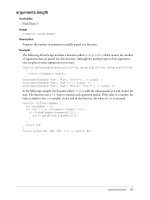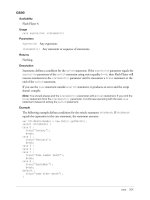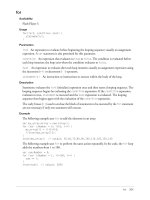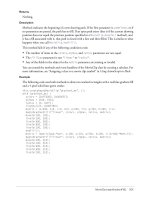Tài liệu Flash: ActionScript Language Reference- P5 docx
Bạn đang xem bản rút gọn của tài liệu. Xem và tải ngay bản đầy đủ của tài liệu tại đây (362.98 KB, 100 trang )
LocalConnection class 401
Event handler summary for the LocalConnection class
Constructor for the LocalConnection class
Availability
Flash Player 6.
Usage
new LocalConnection() : LocalConnection
Parameters
None.
Returns
A reference to a LocalConnection object.
Description
Constructor; creates a LocalConnection object.
Example
The following example shows how receiving and sending SWF files create LocalConnnection
objects. The two SWF files can use the same name or different names for their respective
LocalConnection objects. In this example they use different names.
// Code in the receiving SWF file
this.createTextField("result_txt", 1, 10, 10, 100, 22);
result_txt.border = true;
var receiving_lc:LocalConnection = new LocalConnection();
receiving_lc.methodToExecute = function(param1:Number, param2:Number) {
result_txt.text = param1+param2;
};
receiving_lc.connect("lc_name");
The following SWF file sends the request to the first SWF file.
// Code in the sending SWF file
var sending_lc:LocalConnection = new LocalConnection();
sending_lc.send("lc_name", "methodToExecute", 5, 7);
Event handler Description
LocalConnection.allowDomain
Invoked whenever the current (receiving) LocalConnection
object receives a request to invoke a method from a
sending LocalConnection object.
LocalConnection.allowInsecureDomain
Invoked whenever the current (receiving) LocalConnection
object, which is in a SWF file hosted at a domain using a
secure protocol (HTTPS), receives a request to invoke a
method from a sending LocalConnection object that is in a
SWF file hosted at a non-secure protocol.
LocalConnection.onStatus
Invoked after a sending LocalConnection object tries to
send a command to a receiving LocalConnection object.
402 Chapter 2: ActionScript Language Reference
See also
LocalConnection.connect(), LocalConnection.send()
LocalConnection.allowDomain 403
LocalConnection.allowDomain
Availability
Flash Player 6; behavior changed in Flash Player 7.
Usage
receiving_lc.allowDomain = function([sendingDomain:String]) : Boolean {
// Your statements here return true or false
}
Parameters
sendingDomain
A string that represents an optional parameter specifying the domain of the
SWF file that contains the sending LocalConnection object.
Returns
Nothing.
Description
Event handler; invoked whenever
receiving_lc
receives a request to invoke a method from a
sending LocalConnection object. Flash expects the code you implement in this handler to return
a Boolean value of
true
or
false
. If the handler doesn’t return
true
, the request from the
sending object is ignored, and the method is not invoked.
When this event handler is absent, Flash Player applies a default security policy, which is
equivalent to the following code:
my_lc.allowDomain = function (sendingDomain)
{
return (sendingDomain == this.domain());
}
Use
LocalConnection.allowDomain
to explicitly permit LocalConnection objects from
specified domains, or from any domain, to execute methods of the receiving LocalConnection
object. If you don’t declare the
sendingDomain
parameter, you probably want to accept
commands from any domain, and the code in your handler would be simply
return true
. If you
do declare
sendingDomain
, you probably want to compare the value of
sendingDomain
with
domains from which you want to accept commands. The following examples show both
implementations.
In files authored for Flash Player 6, the
sendingDomain
parameter contains the superdomain of
the caller. In files authored for Flash Player 7 or later, the
sendingDomain
parameter contains the
exact domain of the caller. In the latter case, to allow access by SWF files hosted at either
www.domain.com or store.domain.com, you must explicitly allow access from both domains.
// For Flash Player 6
receiving_lc.allowDomain = function(sendingDomain) {
return(sendingDomain=="domain.com");
}
// For Flash Player 7 or later
receiving_lc.allowDomain = function(sendingDomain) {
return(sendingDomain=="www.domain.com" ||
404 Chapter 2: ActionScript Language Reference
sendingDomain=="store.domain.com");
}
Also, for files authored for Flash Player 7 or later, you can’t use this method to let SWF files
hosted using a secure protocol (HTTPS) allow access from SWF files hosted in nonsecure
protocols; you must use the LocalConnection.allowInsecureDomain event handler instead.
Occasionally, you might encounter the following situation. Suppose you load a child SWF file
from a different domain. You want to implement this method so that the child SWF file can
make LocalConnection calls to the parent SWF file, but you don’t know the final domain from
which the child SWF file will come. This can happen, for example, when you use load-balancing
redirects or third-party servers.
In this situation, you can use the MovieClip._url property in your implementation of this
method. For example, if you load a SWF file into
my_mc
, you can then implement this method by
checking whether the domain argument matches the domain of
my_mc._url
. (You must parse the
domain out of the full URL contained in
my_mc._url
.)
If you do this, make sure that you wait until the SWF file in
my_mc
is loaded, because the
_url
property will not have its final, correct value until the file is completely loaded. The best way to
determine when a child SWF file finishes loading is to use MovieClipLoader.onLoadComplete.
The opposite situation can also occur: You might create a child SWF file that wants to accept
LocalConnection calls from its parent but doesn’t know the domain of its parent. In this situation,
implement this method by checking whether the domain argument matches the domain of
_parent._url.
Again, you must parse the domain out of the full URL from
_parent._url
. In
this situation, you don’t have to wait for the parent SWF file to load; the parent will already be
loaded by the time the child loads.
Example
The following example shows how a LocalConnection object in a receiving SWF file can permit
SWF files from any domain to invoke its methods. Compare this to the example in
LocalConnection.connect()
, in which only SWF files from the same domain can invoke the
trace()
method in the receiving SWF file. For a discussion of the use of the underscore (_) in
the connection name, see
LocalConnection.send()
.
this.createTextField("welcome_txt", this.getNextHighestDepth(), 10, 10, 100,
20);
var my_lc:LocalConnection = new LocalConnection();
my_lc.allowDomain = function(sendingDomain:String) {
domain_txt.text = sendingDomain;
return true;
};
my_lc.allowInsecureDomain = function(sendingDomain:String) {
return (sendingDomain == this.domain());
}
my_lc.sayHello = function(name:String) {
welcome_txt.text = "Hello, "+name;
};
my_lc.connect("_mylc");
LocalConnection.allowDomain 405
The following example sends a string to the previous SWF file and displays a status message about
whether the local connection was able to connect to the file. A TextInput component called
name_ti
, a TextArea instance called
status_ta
and a Button instance called
send_button
are
used to display content.
var sending_lc:LocalConnection;
var sendListener:Object = new Object();
sendListener.click = function(evt:Object) {
sending_lc = new LocalConnection();
sending_lc.onStatus = function(infoObject:Object) {
switch (infoObject.level) {
case 'status' :
status_ta.text = "LocalConnection connected successfully.";
break;
case 'error' :
status_ta.text = "LocalConnection encountered an error.";
break;
}
};
sending_lc.send("_mylc", "sayHello", name_ti.text);
};
send_button.addEventListener("click", sendListener);
In the following example, the receiving SWF file, which resides in thisDomain.com, accepts
commands only from SWF files located in thisDomain.com or thatDomain.com:
var aLocalConn:LocalConnection = new LocalConnection();
aLocalConn.Trace = function(aString) {
aTextField += aString+newline;
};
aLocalConn.allowDomain = function(sendingDomain) {
return (sendingDomain == this.domain() || sendingDomain ==
"www.macromedia.com");
};
aLocalConn.connect("_mylc");
When published for Flash Player 7 or later, exact domain matching is used. This means that the
example will fail if the SWF files are located at www.thatDomain.com but will work if the files are
located at thatDomain.com.
See also
LocalConnection.connect(), LocalConnection.domain(), LocalConnection.send(),
MovieClip._url, MovieClipLoader.onLoadComplete, _parent
406 Chapter 2: ActionScript Language Reference
LocalConnection.allowInsecureDomain
Availability
Flash Player 7.
Usage
receiving_lc.allowInsecureDomain = function([sendingDomain:String]) : Boolean
{
// Your statements here return true or false
}
Parameters
sendingDomain
A string that represents an optional parameter specifying the domain of the
SWF file that contains the sending LocalConnection object.
Returns
A Boolean value.
Description
Event handler; invoked whenever
receiving_lc
, which is in a SWF file hosted at a domain
using a secure protocol (HTTPS), receives a request to invoke a method from a sending
LocalConnection object that is in a SWF file hosted at a nonsecure protocol. Flash expects the
code you implement in this handler to return a Boolean value of
true
or
false
. If the handler
doesn’t return
true
, the request from the sending object is ignored, and the method is
not invoked.
By default, SWF files hosted using the HTTPS protocol can be accessed only by other SWF files
hosted using the HTTPS protocol. This implementation maintains the integrity provided by the
HTTPS protocol.
Using this method to override the default behavior is not recommended, as it compromises
HTTPS security. However, you might need to do so, for example, if you need to permit access to
HTTPS files published for Flash Player 7 or later from HTTP files published for Flash Player 6.
A SWF file published for Flash Player 6 can use the LocalConnection.allowDomain event handler
to permit HTTP to HTTPS access. However, because security is implemented differently in
Flash Player 7, you must use the
LocalConnection.allowInsecureDomain()
method to permit
such access in SWF files published for Flash Player 7 or later.
Example
The following example allows connections from the current domain or from
www.macromedia.com, or allows insecure connections only from the current domain.
this.createTextField("welcome_txt", this.getNextHighestDepth(), 10, 10, 100,
20);
var my_lc:LocalConnection = new LocalConnection();
my_lc.allowDomain = function(sendingDomain:String) {
domain_txt.text = sendingDomain;
return (sendingDomain == this.domain() || sendingDomain ==
"www.macromedia.com");
LocalConnection.allowInsecureDomain 407
};
my_lc.allowInsecureDomain = function(sendingDomain:String) {
return (sendingDomain == this.domain());
}
my_lc.sayHello = function(name:String) {
welcome_txt.text = "Hello, "+name;
};
my_lc.connect("lc_name");
See also
LocalConnection.allowDomain, LocalConnection.connect()
408 Chapter 2: ActionScript Language Reference
LocalConnection.close()
Availability
Flash Player 6.
Usage
receiving_lc.close() : Void
Parameters
None.
Returns
Nothing.
Description
Method; closes (disconnects) a LocalConnection object. Issue this command when you no
longer want the object to accept commands—for example, when you want to issue a
LocalConnection.connect()
command using the same
connectionName
parameter in
another SWF file.
Example
The following example closes a connection called
receiving_lc
when you click a Button
component instance called
close_button
:
this.createTextField("welcome_txt", this.getNextHighestDepth(), 10, 10, 100,
22);
this.createTextField("status_txt", this.getNextHighestDepth(), 10, 42,
100,44);
var receiving_lc:LocalConnection = new LocalConnection();
receiving_lc.sayHello = function(name:String) {
welcome_txt.text = "Hello, "+name;
};
receiving_lc.connect("lc_name");
var closeListener:Object = new Object();
closeListener.click = function(evt:Object) {
receiving_lc.close();
status_txt.text = "connection closed";
};
close_button.addEventListener("click", closeListener);
See also
LocalConnection.connect()
LocalConnection.connect() 409
LocalConnection.connect()
Availability
Flash Player 6.
Usage
receiving_lc.connect(connectionName:String) : Boolean
Parameters
connectionName
A string that corresponds to the connection name specified in the
LocalConnection.send()
command that wants to communicate with
receiving_lc
.
Returns
A Boolean value:
true
if no other process running on the same client computer has already issued
this command using the same value for the
connectionName
parameter;
false
otherwise.
Description
Method; prepares a LocalConnection object to receive commands from a
LocalConnection.send()
command (called the sending LocalConnection object). The object
used with this command is called the receiving LocalConnection object. The receiving and sending
objects must be running on the same client computer.
Make sure you define the methods attached to
receiving_lc
before calling this method, as
shown in all the examples in this section.
By default, Flash Player resolves
connectionName
into a value of
"superdomain:connectionName"
, where
superdomain
is the superdomain of the SWF file
containing the
LocalConnection.connect()
command. For example, if the SWF file
containing the receiving LocalConnection object is located at www.someDomain.com,
connectionName
resolves to
"someDomain.com:connectionName"
. (If a SWF file is located on
the client computer, the value assigned to
superdomain
is
"localhost"
.)
Also by default, Flash Player lets the receiving LocalConnection object accept commands only
from sending LocalConnection objects whose connection name also resolves into a value of
"superdomain:connectionName"
. In this way, Flash makes it simple for SWF files located in the
same domain to communicate with each other.
If you are implementing communication only between SWF files in the same domain, specify a
string for
connectionName
that does not begin with an underscore (_) and that does not specify a
domain name (for example,
"myDomain:connectionName"
). Use the same string in the
LocalConnection.connect(connectionName)
command.
410 Chapter 2: ActionScript Language Reference
If you are implementing communication between SWF files in different domains, specifying a
string for
connectionName
that begins with an underscore (_) will make the SWF with the
receiving LocalConnection object more portable between domains. Here are the two possible
cases:
•
If the string for
connectionName
does not begin with an underscore (_), Flash Player adds a
prefix with the superdomain and a colon (for example,
"myDomain:connectionName"
).
Although this ensures that your connection does not conflict with connections of the same
name from other domains, any sending LocalConnection objects must specify this
superdomain (for example,
"myDomain:connectionName"
). If the SWF with the receiving
LocalConnection object is moved to another domain, the player changes the prefix to reflect
the new superdomain (for example,
"anotherDomain:connectionName"
). All sending
LocalConnection objects would have to be manually edited to point to the new superdomain.
•
If the string for
connectionName
begins with an underscore (for example,
"_connectionName"
), Flash Player does not add a prefix to the string. This means that the
receiving and sending LocalConnection objects will use identical strings for
connectionName
.
If the receiving object uses LocalConnection.allowDomain to specify that connections from
any domain will be accepted, the SWF with the receiving LocalConnection object can be
moved to another domain without altering any sending LocalConnection objects.
For more information, see the discussion of
connectionName
in
LocalConnection.send()
and
also the
LocalConnection.allowDomain
and
LocalConnection.domain()
entries.
Note: Colons are used as special characters to separate the superdomain from the connectionName
string. A string for connectionName that contains a colon is not valid.
Example
The following example shows how a SWF file in a particular domain can invoke a method named
Trace
in a receiving SWF file in the same domain. The receiving SWF file functions as a trace
window for the sending SWF file; it contains two methods that other SWF files can call—
Trace
and
Clear
. Buttons pressed in the sending SWF files call these methods with
specified parameters.
// Receiving SWF
var aLocalConnection:LocalConnection = new LocalConnection();
aLocalConnection.Trace = function(aString):String{
aTextField += aString + newline;
}
aLocalConnection.Clear = function(){
aTextField = "";
}
aLocalConnection.connect("trace");
stop();
SWF 1 contains the following code, which creates a new Sound object that plays back an MP3
file at runtime. A ProgressBar called
playback_pb
displays the playback progress of the MP3 file.
A Label component instance called
song_lbl
displays the name of the MP3 file. Buttons in
different SWF files will be used to control the playback using a LocalConnection object.
var playback_pb:mx.controls.ProgressBar;
var my_sound:Sound;
LocalConnection.connect() 411
playback_pb.setStyle("themeColor", "haloBlue");
this.createEmptyMovieClip("timer_mc", this.getNextHighestDepth());
var receiving_lc:LocalConnection = new LocalConnection();
receiving_lc.playMP3 = function(mp3Path:String, mp3Name:String) {
song_lbl.text = mp3Name;
playback_pb.indeterminate = true;
my_sound = new Sound();
my_sound.onLoad = function(success:Boolean) {
playback_pb.indeterminate = false;
};
my_sound.onSoundComplete = function() {
delete timer_mc.onEnterFrame;
};
timer_mc.onEnterFrame = function() {
playback_pb.setProgress(my_sound.position, my_sound.duration);
};
my_sound.loadSound(mp3Path, true);
};
receiving_lc.connect("lc_name");
SWF 2 contains a button called
play_btn
. When you click the button, it connects to SWF 1 and
passes two variables. The first variable contains the MP3 file to stream, and the second variable is
the filename that you display in the Label component instance in SWF 1.
play_btn.onRelease = function() {
var sending_lc:LocalConnection = new LocalConnection();
sending_lc.send("lc_name", "playMP3", "song1.mp3", "Album - 01 - Song");
};
SWF 3 contains a button called
play_btn
. When you click the button, it connects to SWF 1 and
passes two variables. The first variable contains the MP3 file to stream, and the second variable is
the filename that you display in the Label component instance in SWF 1.
play_btn.onRelease = function() {
var sending_lc:LocalConnection = new LocalConnection();
sending_lc.send("lc_name", "playMP3", "song2.mp3", "Album - 02 - Another
Song");
};
See also
LocalConnection.send()
412 Chapter 2: ActionScript Language Reference
LocalConnection.domain()
Availability
Flash Player 6; behavior changed in Flash Player 7.
Usage
my_lc.domain() : String
Parameters
None.
Returns
A string representing the domain of the location of the current SWF file; for more information,
see the Description section.
Description
Method; returns a string representing the domain of the location of the current SWF file.
In SWF files published for Flash Player 6, the returned string is the superdomain of the current
SWF file. For example, if the SWF file is located at www.macromedia.com, this command returns
"macromedia.com"
.
In SWF files published for Flash Player 7 or later, the returned string is the exact domain of the
current SWF file. For example, if the SWF file is located at www.macromedia.com, this
command returns
"www.macromedia.com"
.
If the current SWF file is a local file residing on the client computer, this command returns
"localhost"
.
The most common way to use this command is to include the domain name of the sending
LocalConnection object as a parameter to the method you plan to invoke in the receiving
LocalConnection object or with LocalConnection.allowDomain to accept commands from a
specified domain. If you are enabling communication only between LocalConnection objects that
are located in the same domain, you probably don’t need to use this command.
Example
In the following example, a receiving SWF file accepts commands only from SWF files located in
the same domain or at macromedia.com:
// If both the sending and receiving SWF files are Flash Player 6,
// then use the superdomain
var my_lc:LocalConnection = new LocalConnection();
my_lc.allowDomain = function(sendingDomain):String{
return (sendingDomain==this.domain() || sendingDomain=="macromedia.com");
}
// If either the sending or receiving SWF file is Flash Player 7 or later,
// then use the exact domain. In this case, commands from a SWF file posted
// at www.macromedia.com will be accepted, but those from one posted at
// a different subdomain, e.g. livedocs.macromedia.com, will not.
var my_lc:LocalConnection = new LocalConnection();
LocalConnection.domain() 413
my_lc.allowDomain = function(sendingDomain):String{
return (sendingDomain==this.domain() ||
sendingDomain=="www.macromedia.com");
}
In the following example, a sending SWF file located at www.yourdomain.com invokes a method
in a receiving SWF file located at www.mydomain.com. The sending SWF file includes its
domain name as a parameter to the method it invokes, so the receiving SWF file can return a
reply value to a LocalConnection object in the correct domain. The sending SWF file also
specifies that it will accept commands only from SWF files at mydomain.com.
Line numbers are included for reference purposes. The sequence of events is described in the
following list:
•
The receiving SWF file prepares to receive commands on a connection named
"sum"
(line 11).
The Flash Player resolves the name of this connection to
"mydomain.com:sum"
(see
LocalConnection.connect()).
•
The sending SWF file prepares to receive a reply on the LocalConnection object named
"result"
(line 67). It also specifies that it will accept commands only from SWF files at
mydomain.com (lines 51 to 53).
•
The sending SWF file invokes the
aSum
method of a connection named
"mydomain.com:sum"
(line 68) and passes the following parameters: its superdomain, the name of the connection to
receive the reply (
"result"
), and the values to be used by
aSum
(123 and 456).
•
The
aSum
method (line 6) is invoked with the following values:
sender =
"mydomain.com:result"
,
replyMethod
=
"aResult"
,
n1
= 123, and
n2
= 456. It
then executes the following line of code:
this.send("mydomain.com:result", "aResult", (123 + 456));
•
The
aResult
method (line 54) shows the value returned by
aSum
(579).
// The receiving SWF at />// contains the following code
1 var aLocalConnection:LocalConnection = new LocalConnection();
2 aLocalConnection.allowDomain = function()
3 {
// Allow connections from any domain
4 return true;
5 }
6 aLocalConnection.aSum = function(sender, replyMethod, n1, n2)
7{
8 this.send(sender, replyMethod, (n1 + n2));
9}
10
11 aLocalConnection.connect("sum");
// The sending SWF at />// contains the following code
50 var lc:LocalConnection = new LocalConnection();
51 lc.allowDomain = function(aDomain) {
// Allow connections only from mydomain.com
414 Chapter 2: ActionScript Language Reference
52 return (aDomain == "mydomain.com");
53 }
54 lc.aResult = function(aParam) {
55 trace("The sum is " + aParam);
56 }
// determine our domain and see if we need to truncate it
57 var channelDomain:String = lc.domain();
58 if (getVersion() >= 7 && this.getSWFVersion() >= 7)
59 {
// split domain name into elements
60 var domainArray:Array = channelDomain.split(".");
// if more than two elements are found,
// chop off first element to create superdomain
61 if (domainArray.length > 2)
62 {
63 domainArray.shift();
64 channelDomain = domainArray.join(".");
65 }
66 }
67 lc.connect("result");
68 lc.send("mydomain.com:sum", "aSum", channelDomain + ':' + "result",
"aResult", 123, 456);
See also
LocalConnection.allowDomain
LocalConnection.onStatus 415
LocalConnection.onStatus
Availability
Flash Player 6.
Usage
sending_lc.onStatus = function(infoObject:Object) : Void{
// your statements here
}
Parameters
infoObject
A parameter defined according to the status message. For details about this
parameter, see the Description section.
Returns
Nothing.
Description
Event handler; invoked after a sending LocalConnection object tries to send a command to a
receiving LocalConnection object. If you want to respond to this event handler, you must create a
function to process the information object sent by the LocalConnection object.
If the information object returned by this event handler contains a
level
value of
status
, Flash
successfully sent the command to a receiving LocalConnection object. This does not mean that
Flash successfully invoked the specified method of the receiving LocalConnection object; it
means only that Flash could send the command. For example, the method is not invoked if the
receiving LocalConnection object doesn’t allow connections from the sending domain or if the
method does not exist. The only way to know for sure if the method was invoked is to have the
receiving object send a reply to the sending object.
If the information object returned by this event handler contains a
level
value of
error
, Flash
cannot send the command to a receiving LocalConnection object, most likely because there is no
receiving LocalConnection object connected whose name corresponds to the name specified in
the
sending_lc.send()
command that invoked this handler.
In addition to this
onStatus
handler, Flash also provides a “super” function called
System.onStatus. If
onStatus
is invoked for a particular object and there is no function assigned
to respond to it, Flash processes a function assigned to
System.onStatus
if it exists.
In most cases, you implement this handler only to respond to error conditions, as shown in the
following example.
Example
The following example displays a status message about whether the SWF file connects to another
local connection object called
lc_name
. A TextInput component called
name_ti
, a TextArea
instance called
status_ta
and a Button instance called
send_button
are used to display content.
var sending_lc:LocalConnection;
var sendListener:Object = new Object();
sendListener.click = function(evt:Object) {
416 Chapter 2: ActionScript Language Reference
sending_lc = new LocalConnection();
sending_lc.onStatus = function(infoObject:Object) {
switch (infoObject.level) {
case 'status' :
status_ta.text = "LocalConnection connected successfully.";
break;
case 'error' :
status_ta.text = "LocalConnection encountered an error.";
break;
}
};
sending_lc.send("lc_name", "sayHello", name_ti.text);
};
send_button.addEventListener("click", sendListener);
See also
LocalConnection.send(), System.onStatus
LocalConnection.send() 417
LocalConnection.send()
Availability
Flash Player 6.
Usage
sending_lc.send (connectionName:String, method:String [, p1,...,pN]) : Boolean
Parameters
connectionName
A string that corresponds to the connection name specified in the
LocalConnection.connect()
command that wants to communicate with
sending_lc
.
method
A string specifying the name of the method to be invoked in the receiving
LocalConnection object. The following method names cause the command to fail:
send
,
connect
,
close
,
domain
,
onStatus
, and
allowDomain
.
p1,...pN
Optional parameters to be passed to the specified method.
Returns
A Boolean value:
true
if Flash can carry out the request;
false
otherwise.
Note: A return value of
true
does not necessarily mean that Flash successfully connected to a
receiving LocalConnection object; it means only that the command is syntactically correct. To
determine whether the connection succeeded, see
LocalConnection.onStatus
.
Description
Method; invokes the method named
method
on a connection opened with the
LocalConnection.connect(connectionName)
command (the receiving LocalConnection
object). The object used with this command is called the sending LocalConnection object.
The SWF files that contain the sending and receiving objects must be running on the same
client computer.
There is a limit to the amount of data you can pass as parameters to this command. If the
command returns
false
but your syntax is correct, try dividing the LocalConnection.send()
requests into multiple commands.
As discussed in the entry LocalConnection.connect(), Flash adds the current superdomain to
connectionName
by default. If you are implementing communication between different
domains, you need to define
connectionName
in both the sending and receiving
LocalConnection objects in such a way that Flash does not add the current superdomain to
connectionName
. You can do this in one of the following two ways:
•
Use an underscore (_) at the beginning of
connectionName
in both the sending and
receiving LocalConnection objects. In the SWF file containing the receiving object, use
LocalConnection.allowDomain to specify that connections from any domain will be accepted.
This implementation lets you store your sending and receiving SWF files in any domain.
418 Chapter 2: ActionScript Language Reference
•
Include the superdomain in
connectionName
in the sending LocalConnection object—for
example,
myDomain.com:myConnectionName
. In the receiving object, use
LocalConnection.allowDomain to specify that connections from the specified superdomain
will be accepted (in this case, myDomain.com) or that connections from any domain will
be accepted.
Note: You cannot specify a superdomain in
connectionName
in the receiving LocalConnection
object—you can only do this in the sending LocalConnection object.
Example
For an example of communicating between LocalConnection objects located in the same domain,
see LocalConnection.connect(). For an example of communicating between LocalConnection
objects located in any domain, see LocalConnection.allowDomain. For an example of
communicating between LocalConnection objects located in specified domains, see
LocalConnection.allowDomain and LocalConnection.domain().
See also
LocalConnection.allowDomain, LocalConnection.connect(),
LocalConnection.domain(), LocalConnection.onStatus
Math class 419
Math class
Availability
Flash Player 5. In Flash Player 4, the methods and properties of the Math class are emulated using
approximations and might not be as accurate as the non-emulated math functions that Flash
Player 5 supports.
Description
The Math class is a top-level class whose methods and properties you can use without using
a constructor.
Use the methods and properties of this class to access and manipulate mathematical constants and
functions. All the properties and methods of the Math class are static and must be called using the
syntax
Math.method(parameter)
or
Math.constant
. In ActionScript, constants are defined
with the maximum precision of double-precision IEEE-754 floating-point numbers.
Several Math class methods use the measure of an angle in radians as a parameter.You can use the
following equation to calculate radian values before calling the method and then provide the
calculated value as the parameter, or you can provide the entire right side of the equation (with
the angle’s measure in degrees in place of
degrees
) as the radian parameter.
To calculate a radian value, use the following formula:
radians = degrees * Math.PI/180
The following is an example of passing the equation as a parameter to calculate the sine of a 45
º
angle:
Math.sin(45 * Math.PI/180)
is the same as
Math.sin(.7854)
Method summary for the Math class
Method Description
Math.abs()
Computes an absolute value.
Math.acos()
Computes an arc cosine.
Math.asin()
Computes an arc sine.
Math.atan()
Computes an arc tangent.
Math.atan2()
Computes an angle from the x-axis to the point.
Math.ceil()
Rounds a number up to the nearest integer.
Math.cos()
Computes a cosine.
Math.exp()
Computes an exponential value.
Math.floor()
Rounds a number down to the nearest integer.
Math.log()
Computes a natural logarithm.
Math.max()
Returns the larger of the two integers.
Math.min()
Returns the smaller of the two integers.
CHAPTER 2
ActionScript Language Reference
420 Chapter 2: ActionScript Language Reference
Property summary for the Math class
All the following properties for the Math class are constants:
Math.pow()
Computes
x
raised to the power of the
y
.
Math.random()
Returns a pseudo-random number between 0.0 and 1.0.
Math.round()
Rounds to the nearest integer.
Math.sin()
Computes a sine.
Math.sqrt()
Computes a square root.
Math.tan()
Computes a tangent.
Property Description
Math.E
Euler’s constant and the base of natural logarithms (approximately 2.718).
Math.LN2
The natural logarithm of 2 (approximately 0.693).
Math.LOG2E
The base 2 logarithm of e (approximately 1.442).
Math.LN2
The natural logarithm of 10 (approximately 2.302).
Math.LOG10E
The base 10 logarithm of e (approximately 0.434).
Math.PI
The ratio of the circumference of a circle to its diameter (approximately 3.14159).
Math.SQRT1_2
The reciprocal of the square root of 1/2 (approximately 0.707).
Math.SQRT2
The square root of 2 (approximately 1.414).
Method Description
Math.abs() 421
Math.abs()
Availability
Flash Player 5. In Flash Player 4, the methods and properties of the Math class are emulated using
approximations and might not be as accurate as the non-emulated math functions that Flash
Player 5 supports.
Usage
Math.abs(x:Number) : Number
Parameters
x
A number.
Returns
A number.
Description
Method; computes and returns an absolute value for the number specified by the parameter
x
.
Example
The following example shows how
Math.abs()
returns the absolute value of a number and does
not affect the value of the
x
parameter (called
num
in this example):
var num:Number = -12;
var numAbsolute:Number = Math.abs(num);
trace(num); // output: -12
trace(numAbsolute); // output: 12
422 Chapter 2: ActionScript Language Reference
Math.acos()
Availability
Flash Player 5. In Flash Player 4, the methods and properties of the Math class are emulated using
approximations and might not be as accurate as the non-emulated math functions that Flash
Player 5 supports.
Usage
Math.acos(x:Number) : Number
Parameters
x
A number from -1.0 to 1.0.
Returns
A number; the arc cosine of the parameter
x
.
Description
Method; computes and returns the arc cosine of the number specified in the parameter
x
,
in radians.
Example
The following example displays the arc cosine for several values.
trace(Math.acos(-1)); // output: 3.14159265358979
trace(Math.acos(0)); // output: 1.5707963267949
trace(Math.acos(1)); // output: 0
See also
Math.asin(), Math.atan(), Math.atan2(), Math.cos(), Math.sin(), Math.tan()
Math.asin() 423
Math.asin()
Availability
Flash Player 5. In Flash Player 4, the methods and properties of the Math class are emulated using
approximations and might not be as accurate as the non-emulated math functions that Flash
Player 5 supports.
Usage
Math.asin(x:Number) : Number;
Parameters
x
A number from -1.0 to 1.0.
Returns
A number between negative pi divided by 2 and positive pi divided by 2.
Description
Method; computes and returns the arc sine for the number specified in the parameter
x
,
in radians.
Example
The following example displays the arc sine for several values.
trace(Math.asin(-1)); // output: -1.5707963267949
trace(Math.asin(0)); // output: 0
trace(Math.asin(1)); // output: 1.5707963267949
See also
Math.acos(), Math.atan(), Math.atan2(), Math.cos(), Math.sin(), Math.tan()
424 Chapter 2: ActionScript Language Reference
Math.atan()
Availability
Flash Player 5. In Flash Player 4, the methods and properties of the Math class are emulated using
approximations and might not be as accurate as the non-emulated math functions that Flash
Player 5 supports.
Usage
Math.atan(tangent:Number) : Number
Parameters
tangent
A number that represents the tangent of an angle.
Returns
A number between negative pi divided by 2 and positive pi divided by 2.
Description
Method; computes and returns the value, in radians, of the angle whose tangent is specified in the
parameter
tangent
. The return value is between negative pi divided by 2 and positive pi divided
by 2.
Example
The following example displays the angle value for several tangents.
trace(Math.atan(-1)); // output: -0.785398163397448
trace(Math.atan(0)); // output: 0
trace(Math.atan(1)); // output: 0.785398163397448
See also
Math.acos(), Math.asin(), Math.atan2(), Math.cos(), Math.sin(), Math.tan()
Math.atan2() 425
Math.atan2()
Availability
Flash Player 5. In Flash Player 4, the methods and properties of the Math class are emulated using
approximations and might not be as accurate as the non-emulated math functions that Flash
Player 5 supports.
Usage
Math.atan2(y:Number, x:Number) : Number
Parameters
y
A number specifying the y coordinate of the point.
x
A number specifying the x coordinate of the point.
Returns
A number.
Description
Method; computes and returns the angle of the point
y
/
x
in radians, when measured
counterclockwise from a circle’s x axis (where 0,0 represents the center of the circle). The return
value is between positive pi and negative pi.
Example
The following example displays the following radians from the specified coordinates 10, 0.
trace(Math.atan2(10, 0)); // output: 1.5707963267949
See also
Math.acos(), Math.asin(), Math.atan(), Math.cos(), Math.sin(), Math.tan()









